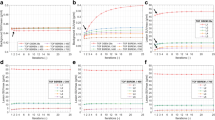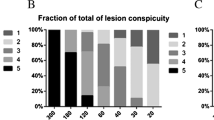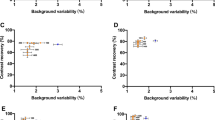Abstract
Purpose
This study aims to determine whether Q.Clear positron emission tomography (PET) reconstruction may reduce tracer injection dose or shorten scanning time in 68Gallium-labelled fibroblast activation protein inhibitor (68 Ga-FAPI) PET/magnetic resonance (MR) imaging.
Methods
We retrospectively collected cases of 68 Ga-FAPI whole-body imaging performed on integrated PET/MR. PET images were reconstructed using three different methods: ordered subset expectation maximization (OSEM) reconstruction with full scanning time, OSEM reconstruction with half scanning time, and Q.Clear reconstruction with half scanning time. We then measured standardized uptake values (SUVs) within and around lesions, alongside their volumes. We also evaluated image quality using lesion-to-background (L/B) ratio and signal-to-noise ratio (SNR). We then compared these metrics across the three reconstruction techniques using statistical methods.
Results
Q.Clear reconstruction significantly increased SUVmax and SUVmean within lesions (more than 30%) and reduced their volumes in comparison with OSEM reconstruction. Background SUVmax also increased significantly, while background SUVmean showed no difference. Average L/B values for Q.Clear reconstruction were only marginally higher than those from OSME reconstruction with half-time. SNR decreased significantly in Q.Clear reconstruction compared with OSEM reconstruction with full time (but not half time). Differences between Q.Clear and OSEM reconstructions in SUVmax and SUVmean values within lesions were significantly correlated with SUVs within lesions.
Conclusions
Q.Clear reconstruction was useful for reducing PET injection dose or scanning time while maintaining the image quality. Q.Clear may affect PET quantification, and it is necessary to establish diagnostic recommendations based on Q.Clear results for Q.Clear application.





Similar content being viewed by others
Data availability
The datasets analyzed during the current study are available from the corresponding author on reasonable request.
References
Reader AJ, Zaidi H. Advances in PET image reconstruction. PET clinics. 2007;2(2):173–90.
Shoji A, Morita K, Kimoto S, Hashimoto N, Tsutsui Y, Himuro K, et al. The influence of the subset number on the quality of OSEM-reconstructed PET images. J Nucl Med. 2017;58:1109.
Rizzo G, Castiglioni I, Russo G, Tana MG, Dell’Acqua F, Gilardi MC, et al. Using deconvolution to improve PET spatial resolution in OSEM iterative reconstruction. Methods Inf Med. 2007;46(2):231–5.
Chilcott AK, Bradley KM, McGowan DR. Effect of a Bayesian penalized likelihood PET reconstruction compared with ordered subset expectation maximization on clinical image quality over a wide range of patient weights. Am J Roentgenol. 2018;210(1):153–7.
Mokri SS, Saripan MI, Abd Rahni AA, et al. PET image reconstruction incorporating 3D mean-median sinogram filtering. IEEE Trans Nucl Sci. 2016;63(1): 157–169.
Panin VY, Kehren F, Michel C, Casey M. Fully 3-D PET reconstruction with system matrix derived from point source measurements. IEEE Trans Med Imaging. 2006;25:907–21.
Conti M, Bendriem B, Casey M, Chen M, Kehren F, Michel C, et al. First experimental results of time-of-flight reconstruction on an LSO PET scanner. Phys Med Biol. 2007;52:2335–43.
Rapisarda E, Bettinardi V, Thielemans K, Gilardi MC. Image-based point spread function implementation in a fully 3D OSEM reconstruction algorithm for PET. Phys Med Biol. 2010;55:4131–51.
Tong S, Alessio AM, Thielemans K, Stearns C, Ross S, Kinahan PE. Properties and mitigation of edge artifacts inPSF-based PET reconstruction. Nucl Sci IEEE Trans. 2011;58:2264–75.
Armstrong IS, Kelly MD, Williams HA, Matthews JC. Impact of point spread function modelling and time of flight on FDG uptake measurements in lung lesions using alternative filtering strategies. EJNMMI Phys. 2014;1(1):99.
Akamatsu G, Mitsumoto K, Taniguchi T, Tsutsui Y, Baba S, Sasaki M. Influences of point-spread function and time-of-flight reconstructions on standardized uptake value of lymph node metastases in FDG-PET. Eur J Radiol. 2014;83(1):226–30.
Surti S, Karp JS. Advances in time-of-flight PET. Phys Med. 2016;32(1):12–22.
Wimalarathne DDN, Ruan W, Sun X, Liu F, Gai Y, Liu Q, et al. Impact of TOF on brain PET with short-lived C-11-labeled tracers among suspected patients with AD/PD: using hybrid PET/MRI. Front Med. 2022;9: 823292.
Karp JS, Surti S, Daube-Witherspoon ME, Muehllehner G. Benefit of time-of-flight in PET: experimental and clinical results. J Nucl Med. 2008;49:462–70.
GE Healthcare, PET/CT millennium specifics, http://www3.gehealthcare.co.uk/engb/products/categories/molecular_imaging/pet-ct/discovery_mi. Accessed 21 Nov 2018.
Teoh EJ, McGowan RD, Macpherson RE, Bradley KM, Gleeson FV. Phantom and clinical evaluation of the Bayesian penalized like-lihood reconstruction algorithm Q.Clear on an L YSO PET/CT system. J Nucl Med. 2015; 56: 1447–52.
Rogasch JM., Suleiman S, Hofheinz F, Bluemel S, Lukas M, Amthauer H, et al. Reconstructed spatial resolution and contrast recovery with Bayesian penalized likelihood reconstruction (Q.Clear) for FDG-PET compared to time-of-flight (TOF) with point spread function (PSF). EJNMMI Phys. 2020; 7(1). https://doi.org/10.1186/s40658-020-0270-y.
Tian DF, Yang HW, Li Y, Cui BX and Lu J. The effect of Q.Clear reconstruction on quantification and spatial resolution of 18F-FDG PET in simultaneous PET/MR. EJNMMI Phys. 2022; 9(1). https://doi.org/10.1186/s40658-021-00428-w.
Ribeiro D, Hallett W, Howes O, McCutcheon R, Nour MM and Tavares AAS. Assessing the impact of different penalty factors of the Bayesian reconstruction algorithm Q.Clear on in vivo low count kinetic analysis of C-11 PHNO brain PET-MR studies. EJNMMI Res. 2022; 12(1). https://doi.org/10.1186/s13550-022-00883-1.
Wagatsuma K, Miwa K, Kamitaka Y, Koike E, Yamao T, Yoshii T, et al. Determination of optimal regularization factor in Bayesian penalized likelihood reconstruction of brain PET images using F-18 FDG and C-11 PiB. Med Phys. 2022;49(5):2995–3005.
Liu Y, Gao MJ, Zhou J, Du F, Chen L, Huang ZK, et al. Changes of F-18 FDG-PET/CT quantitative parameters in tumor lesions by the Bayesian penalized-likelihood PET reconstruction algorithm and its influencing factors. BMC Med Imag. 2021;21(1):133.
Roef MJ, Rijnsdorp S, Brouwer C, Wyndaele DN, Arends AJ. Evaluation of quantitative Ga-68 PSMA PET/CT repeatability of recurrent prostate cancer lesions using both OSEM and Bayesian penalized likelihood reconstruction algorithms. Diagnostics. 2021;11(6):1100.
Wagatsuma K, Miwa K, Kamitaka Y, Koike E, Yamao T, Yoshii T, et al. Determination of optimal regularization factor in Bayesian penalized likelihood reconstruction of brain PET images using F-18 FDG and C-11 PiB. Med Phy. 2022;49(5):2995–3005.
Wyrzykowski M, Siminiak N, Kazmierczak M, Ruchala M and Czepczynski R. Impact of the Q.Clear reconstruction algorithm on the interpretation of PET/CT images in patients with lymphoma. EJNMMI Res. 2020; 10(1). https://doi.org/10.1186/s13550-020-00690-6.
Qin CX, Shao FQ, Gai YK, Liu QY, Ruan WW, Liu F, et al. Ga-68-DOTA-FAPI-04 PET/MR in the evaluation of gastric carcinomas: comparison with F-18-FDG PET/CT. J Nucl Med. 2022;63(1):81–8.
Qin CX, Liu F, Huang J, Ruan WW, Liu QY, Gai YK, et al. A head-to-head comparison of Ga-68-DOTA-FAPI-04 and F-18-FDG PET/MR in patients with nasopharyngeal carcinoma: a prospective study. Eur J Nucl Med Mol Imaging. 2021;48(10):3228–37.
Elboga U, Sahin E, Cayirli YB, Okuyan M, Aktas G, Sahin HH, et al. Comparison of 68Ga-FAPI PET/CT and 18F-FDG PET/CT in multiple myeloma: clinical experience. Tomography. 2022;8(1):293–302.
Qin CX, Song YM, Cai WB, Lan XL. Dimeric FAPI with potential for tumor theranostics. Am J Nucl Med Mol Imaging. 2021;11(6):537–41.
Qin CX, Song YMH, Liu X, Gai YK, Liu QY, Ruan WW, et al. Increased uptake of Ga-68-DOTA-FAPI-04 in bones and joints: metastases and beyond. Eur J Nucl Med Mol Imaging. 2022;49(2):709–20.
Vallot D, De Ponti E, Morzenti S, Gramek A, Pieczonka A, Llompart GR, et al. Evaluation of PET quantitation accuracy among multiple discovery IQ PET/CT systems via NEMA image quality test. EJNMMI Phys. 2020; 7(1). https://doi.org/10.1186/s40658-020-00294-y.
Ribeiro D, Hallett W and Tavares AAS. Performance evaluation of the Q.Clear reconstruction framework versus conventional reconstruction algorithms for quantitative brain PET-MR studies. EJNMMI Phys. 2021; 8(1):41. https://doi.org/10.1186/s40658-021-00386-3.
Teoh EJ, McGowan DR, Macpherson RE, Bradley KM and Gleeson FV. Phantom and clinical evaluation of the Bayesian penalized likelihood reconstruction algorithm Q.Clear on an LYSO PET/CT system. J Nucl Med. 2015; 56(9): 1447–1452.
Ruan WW, Liu F, Sun X, Hu F, Wu TF, Zhang YX, et al. Evaluating two respiratory correction methods for abdominal PET/MRI imaging. EJNMMI Phys. 2022; 9(1): 5. https://doi.org/10.1186/s40658-022-00430-w.
Wollenweber SD, Ambwani S. Comparison of 4-class and continuous fat/water methods for whole-body, MR based PET attenuation correction. IEEE Trans Nucl Sci. 2013;60(5):3391–8.
Zhang H, Inoue T, Tian M, Alyafei S, Oriuchi N, Khan N, et al. A basic study on lesion detectability for hot spot imaging of positron emitters with dedicated PET and positron coincidence gamma camera. Ann Nucl Med. 2001;15(3):301–6.
Rogasch JMM, Steffen IG, Hofheinz F, Grosser OS, Furth C, Mohnike K, et al. The association of tumor-to-background ratios and SUVmax deviations related to point spread function and time-of-flight 18F-FDG-PET/CT reconstruction in colorectal liver metastases. EJNMMI Res. 2015;5:31. https://doi.org/10.1186/s13550-015-0111-5.
Funding
This work was financially supported by the National Natural Science Foundation of China (No. 81901735), Key Project of Natural Science Foundation of Hubei Province (No. 2021CFA008), and Key Project of Hubei Province Technical Innovation (No. 2017ACA182).
Author information
Authors and Affiliations
Contributions
W. Ruan and X. Lan contributed to the study conception and design. Material preparation, data collection, and analysis were performed by W. Ruan, C. Qin, F. Liu, R. Pi, Y. Gai, and Q. Liu. The first draft of the manuscript was written by W. Ruan, and all authors commented on previous versions of the manuscript. All authors read and approved the final manuscript.
Corresponding author
Ethics declarations
Ethics approval
This article does not contain any experiments with animals. All procedures involving human participants were carried out in accordance with the ethical standards of the institutional and/or national research committee and with the 1964 Helsinki Declaration and its later amendments or comparable ethical standards. This study was approved by the Clinical Research Ethics Committee of Union Hospital, Tongji Medical College, Huazhong University of Science and Technology (NO. 20200290).
Consent to participate
Written informed consent was obtained from the parents in the study.
Competing interests
The authors declare no competing interests.
Additional information
Publisher's note
Springer Nature remains neutral with regard to jurisdictional claims in published maps and institutional affiliations.
This article is part of the Topical Collection on Technology.
Rights and permissions
Springer Nature or its licensor (e.g. a society or other partner) holds exclusive rights to this article under a publishing agreement with the author(s) or other rightsholder(s); author self-archiving of the accepted manuscript version of this article is solely governed by the terms of such publishing agreement and applicable law.
About this article
Cite this article
Ruan, W., Qin, C., Liu, F. et al. Q.Clear reconstruction for reducing the scanning time for 68 Ga-DOTA-FAPI-04 PET/MR imaging. Eur J Nucl Med Mol Imaging 50, 1851–1860 (2023). https://doi.org/10.1007/s00259-023-06134-2
Received:
Accepted:
Published:
Issue Date:
DOI: https://doi.org/10.1007/s00259-023-06134-2




